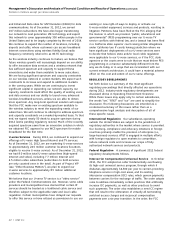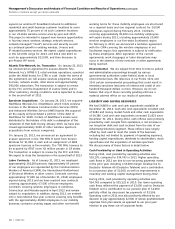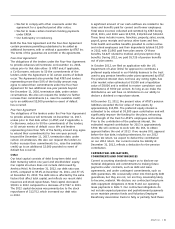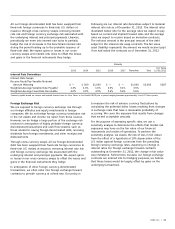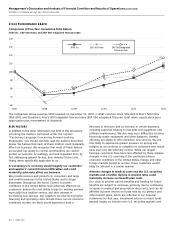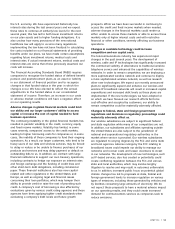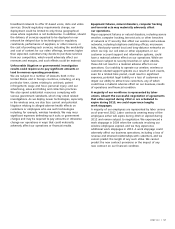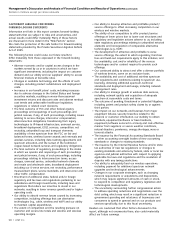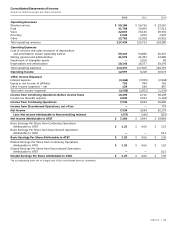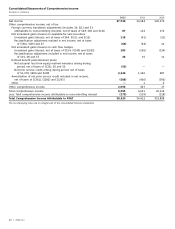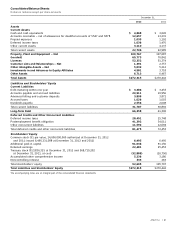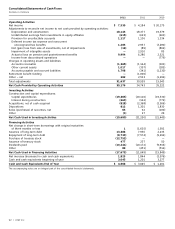AT&T Wireless 2012 Annual Report Download - page 54
Download and view the complete annual report
Please find page 54 of the 2012 AT&T Wireless annual report below. You can navigate through the pages in the report by either clicking on the pages listed below, or by using the keyword search tool below to find specific information within the annual report.
Management’s Discussion and Analysis of Financial Condition and Results of Operations (continued)
Dollars in millions except per share amounts
52 | AT&T Inc.
benefits (see Note 11). In the ordinary course of business, we
routinely enter into commercial commitments for various
aspects of our operations, such as plant additions and office
supplies. However, we do not believe that the commitments
will have a material effect on our financial condition, results
of operations or cash flows.
Our contractual obligations as of December 31, 2012, are
in the following table. The purchase obligations that follow
are those for which we have guaranteed funds and will be
funded with cash provided by operations or through
incremental borrowings. The minimum commitment for
certain obligations is based on termination penalties that
could be paid to exit the contract. Since termination
penalties would not be paid every year, such penalties are
excluded from the table. Other long-term liabilities were
included in the table based on the year of required payment
or an estimate of the year of payment. Such estimate of
payment is based on a review of past trends for these items,
as well as a forecast of future activities. Certain items were
excluded from the following table, as the year of payment
is unknown and could not be reliably estimated since
past trends were not deemed to be an indicator of
future payment.
Substantially all of our purchase obligations are in our
Wireline and Wireless segments. The table does not include
the fair value of our interest rate swaps. Our capital lease
obligations and bank borrowings have been excluded from
the table due to the insignificant amounts of such obligations
at December 31, 2012. Many of our other noncurrent
liabilities have been excluded from the following table due to
the uncertainty of the timing of payments, combined with the
absence of historical trending to be used as a predictor of
such payments. Additionally, certain other long-term liabilities
have been excluded since settlement of such liabilities will
not require the use of cash. However, we have included, in
the following table, obligations that primarily relate to benefit
funding due to the certainty of the timing of these future
payments. Our other long-term liabilities are: deferred income
taxes (see Note 10) of $28,491; postemployment benefit
obligations of $41,392; and other noncurrent liabilities of
$11,592, which included deferred lease revenue from our
agreement with American Tower Corp. of $420 (see Note 14).
Contractual Obligations
Payments Due By Period
Less than 1-3 3-5 More than
Total 1 Year Years Years 5 Years
Long-term debt obligations1 $ 71,035 $ 3,475 $10,302 $ 9,680 $ 47,578
Interest payments on long-term debt 60,174 3,446 6,503 5,670 44,555
Operating lease obligations 24,065 2,706 5,102 4,502 11,755
Unrecognized tax benefits2 2,945 258 — — 2,687
Purchase obligations3 9,560 3,744 3,890 1,469 457
Retirement benefit funding obligation4 300 300 — — —
Total Contractual Obligations $168,079 $13,929 $25,797 $21,321 $107,032
1
Represents principal or payoff amounts of notes and debentures at maturity or, for putable debt, the next put opportunity.
2
The noncurrent portion of the UTBs is included in the “More than 5 Years” column, as we cannot reasonably estimate the timing or amounts of additional cash payments, if
any, at this time. See Note 10 for additional information.
3
We calculated the minimum obligation for certain agreements to purchase goods or services based on termination fees that can be paid to exit the contract. If we elect to
exit these contracts, termination fees for all such contracts in the year of termination could be approximately $898 in 2013, $989 in the aggregate for 2014 and 2015, $467
in the aggregate for 2016 and 2017, and $352 in the aggregate thereafter. Certain termination fees are excluded from the above table, as the fees would not be paid every
year and the timing of such payments, if any, is uncertain.
4
Required contribution to our pension plans (see Note 11). Future required pension funding will be determined in accordance with ERISA regulations.
MARKET RISK
We are exposed to market risks primarily from changes in
interest rates and foreign currency exchange rates. These
risks, along with other business risks, impact our cost of
capital. It is our policy to manage our debt structure and
foreign exchange exposure in order to manage capital costs,
control financial risks and maintain financial flexibility over
the long term. In managing market risks, we employ
derivatives according to documented policies and procedures,
including interest rate swaps, interest rate locks, foreign
currency exchange contracts and combined interest rate
foreign currency contracts (cross-currency swaps). We do not
use derivatives for trading or speculative purposes. We do
not foresee significant changes in the strategies we use to
manage market risk in the near future.
Interest Rate Risk
The majority of our financial instruments are medium- and
long-term fixed-rate notes and debentures. Changes in
interest rates can lead to significant fluctuations in the fair
value of these instruments. The principal amounts by
expected maturity, average interest rate and fair value of
our liabilities that are exposed to interest rate risk are
described in Notes 8 and 9. In managing interest expense,
we control our mix of fixed and floating rate debt,
principally through the use of interest rate swaps. We have
established interest rate risk limits that we closely monitor
by measuring interest rate sensitivities in our debt and
interest rate derivatives portfolios.


